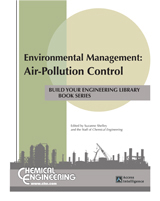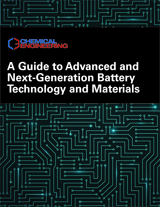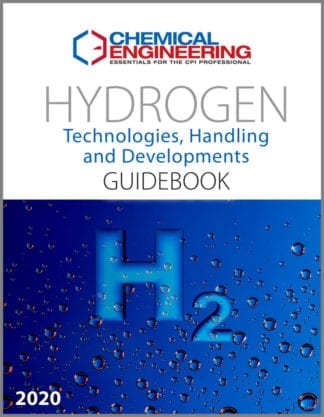| CHAPTERS: .Chapter 1. NOx and SOx control; Chapter 2. Managing gaseous emissions; Chapter 3. Managing particulate emissions; Chapter 4. Emissions monitoring; Chapter 5. Data and calculations; Chapter 6. Safety-related issues; Chapter 7. Related topics |
| The two faces of NOx control |
Charles Botsford, Parsons Engineering Science |
| NOx control techniques for the CPI |
Darlene Lambert and Thomas F. McGowan, RMT/Four Nines, Inc. |
| Find the right low-NOx solution |
Harold L. Shelton, Con-Serve, Inc. |
| Cost-effective NOx reduction |
Ravindra Agrawal and Stephen Wood, Entropy Technology and Enviro. Consultants |
| For NOx control, try a ‘layered’ approach |
Ravi Krishnan, RJM Corp. |
| SCR tackles NOx and Ammonia despite high NOx, dust and SOx loadings |
Robert Hernquist, Huntington Environmental Systems |
| Selecting the solvent for SO2 removal absorption |
Soumitro Nagpal and P.K. Sen, Engineers India Ltd. |
| Solubility & Henry’s Law constants for sulfur compounds in water |
Carl Yaws, Praveen Bajaj and Harman Singh, Lamar University, Ralph Pike, Louisiana State University |
| Exploring VOC control options |
Jeffrey H. Siegell, Exxon Research and Engineering Co. |
|
|
| Abating halogenated VOCs |
Robert Keller and James Dyer, DuPont Co. |
| Reduce solvent emissions |
Ravindra Waghmare, Thadomai Shahani Engineering College |
| Odor prevention and control in process plants |
Terry Robbins and Roy Manley, BetzDearborn |
| Removing H2S from gas streams |
Gary Nagl, USFilter Gas Technology Products |
| Controlling H2S emissions |
Gary Nagl, U.S. Filter Corp. |
| Taking stock of activated carbon’s many talents |
Stephanie Carr and Robert Vaughn, Calgon Carbon |
| Analyze a spray scrubber the easy way |
Peter Brekelmans, TurboSonic Inc. |
| Scrubbers with a level head |
George C. Pedersen, Kimre, Inc., P.K. Bhattachararjee, U.S. Agri-Chemical Corp. |
| Wet scrubbers: Choose the best reagent |
Ing. Noe Ugo Rinaldi, Tecnochim s.r.l. |
| Wet scrubbers: Match the spray nozzle to the operation |
Lothar Bendig, Lechler GmbH & Co. |
| Demystifying mist eliminator selection |
Steven Ziebold, Monsanto Enviro-Chem Systems, Inc. |
| Burning waste fuel |
Olavo Leite, Thermica Technologies |
| Hazardous-waste incinerators: Meeting compliance challenges |
Duncan Kimbro and Robert McCormick, Franklin Engineering Group, Phil Knisley and Janet Evans, Eastman Chemical Co. |
| Incineration: Tested & true |
Charles E. Campbell, Jr., T-Thermal Co. |
|
|
| Pollutant destruction: Comparing thermal-oxidizer designs |
Joseph Klobucar, Durr Environmental |
| Destroying gaseous emissions: Pick the right thermal oxidizer |
Mudumbai Venkatesh and John Woodhull, ENSR Corp. |
| VOC control: Thermal vs. catalytic oxidation |
Stan Mack, Engelhard Corp. |
| Predicting actual incinerator system capacity |
Saleem Zwayyed, IT Corp., Rudy Novak, RGN Consultants |
| Operating thermal incinerators safely |
Olavo Leite, T-Thermal Co., a div. Of Selas Fluid Processing Corp. |
| Managing emissions during hazardous-waste combustion |
Doolittle, John Woodhull and Mudumbai Venkatesh, ENSR International |
| Control dioxin emissions from combustion processes |
Jesus Blanco, Esperanza Alvarez and Carlos Knapp, The Spanish Council for Scientific Research’s Inst. Of Catalysis |
| Cleaning up incineration exhaust |
Olavo Leite, T-Thermal |
| Quenching hot exhaust — A key aspect of pollution control |
Wayne Buckley and Boris Altshuler, Croll-Reynolds Co. |
|
|
| Design & operate flares safely |
Ajay Kumar, The Sapphire Group |
| Clearing the air about flare systems |
John Straitz, NAO, Inc. |
| Dust collection in the CPI |
Tom Siljkovic, TS Consulting |
|
|
| Particulate emissions: Evaluating removal methods |
Isaac Ray, Croll-Reynolds Co. |
| New developments in filter dust collection |
Miles Croom, DCAD Co. |
| Keep pulse-jet baghouses running well |
Robert Zielinski, Met-Pro Corp., Flex-Kleen Div. (retired) |
| Beating the baghouse blues |
Lutz Bermann, Filter Media Consulting |
| How to monitor pulse-jet baghouses |
Herbert H. Nierman, Consultant, and Alex M. Hood, Kimberly-Clark Corp. |
| Assessing electrostatic precipitator performance |
Joao Bordado, Hoechst Portuguesa, and the Technical University of Lisbon, and Joao F.P. Gomes, Environmental Technologies Center, Instituto de Soldadura e Qualidade |
| Ductwork changes improve ESP performance |
Clive Grainger, CSIRO (Australia), Energy Thermal & Fluids Engineering and Colin Paulson, CSIRO (Australia), Division of Energy Technology |
| A simple way to measure particle size in fluegases |
Joao Gomes, Environmental Technologies Center, Instituto de Soldadura e Qualidade |
| Survey your options: Continuous emissions monitoring |
John R. White, KVB/Analect |
| How to choose emission monitors |
Robert Bucher, DuPont Co. |
| For effective gas detection, location counts |
Jay J. Jablonski, HSB Professional Loss Control |
| Comparing catalytic vs. infrared gas monitors |
Alan Austin, General Monitors |
|
|
| Protect workers and the environment: Choosing fixed-point gas sensors |
Alan Austin, General Monitors |
| CHAPTER 5. DATA AND CALCULATIONS |
| Estimating the lower explosive limits of waste vapors |
Harold L. Shelton, Con-Serve, Inc. |
| Estimating hazard distances from accidental releases |
Ajay Kumar, The Sapphire Group |
| Estimate emissions from atmospheric releases of hazardous substances |
Ajay Kumar, EA Engineering, Science and Technology, Inc. |
| Quick estimates for hazardous-gas releases |
Ajay Kumar, Sandi Wiedenbaum and Michael Woodman, EA Engineering, Science and Technology, Inc. |
| Coping with hazardous leaks and spills |
Merrill Bishop, TransEnvironmental Systems |
| Preparing employees for spill response |
Karen Hamel, New Pig Corp. |
| Suiting up for safety in hazardous workplaces |
James Zeigler, Thomas Neal and Norman Henry, DuPont Co. |
| Reusing chemical-cartridge respirators |
Craig Colton, 3M |
| Prevent thermal runaways in carbon beds |
Thomas Hofelich, Marabeth LaBarge and Denise Drott, Dow Chemical Co. |
| Extremely hazardous substances’ — A focus on safer operations |
George Kinsley, Environmental Resources Management |
| Avoid process engineering mistakes |
Ian Duguid, Consultant |
| VOC control: Managing hazardous waste containers |
Karen Hamel, New Pig Corp. |
| How emissions affect design and performance of packaged boilers |
V. Ganapathy, ABCO Industries |
| VOC-control options during wastewater treatment |
Victor Edwards, Kvaerner Engineers & Constructors |
| Boosting environmental performance…reducing regulatory noncompliance |
Charles Gillard, C.F. Gillard Assoc., Bob Wood, Verticore Technologies |
| Pollution prevention: Don’t neglect it |
Virangkumar N. Lad, S.V. Regional College of Engineering and Technology |
| Pollution prevention by design |
Paul Crumpler, Georgia Dept. of Natural Resources |
| Consider outsourcing to reduce costs |
John Sudnick and William Falls, Peregrine Energy Corp. |
| Resolving environmental disputes without litigation |
Steven Koyasako, California Environmental Protection Agency, Dept. of Toxic Substances Control |
| Get the most from environmental audits |
Anne Marie McManus, Malcolm Pirnie, Inc. |
| Keeping pipelines safe from harm |
Brian Payne, EDM Services |
| Selecting secondary containment piping |
Anthony Palozzolo, Perma-Pipe, Inc. |




